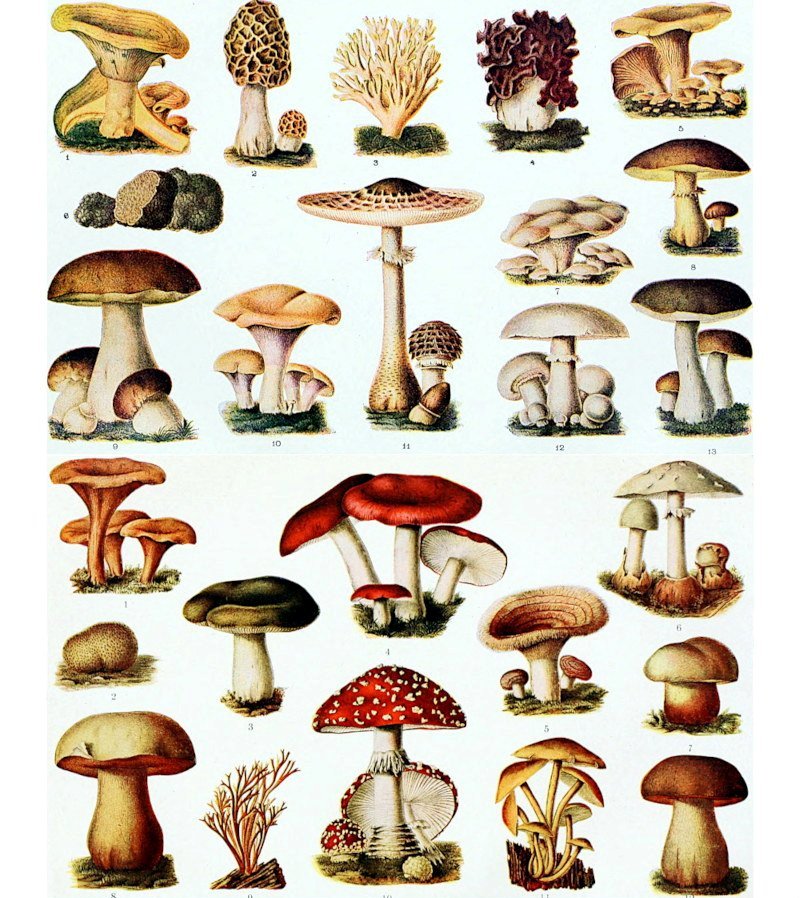Difference between revisions of "Mushroom Hunt (sage ability)"
Tao alexis (talk | contribs) |
|||
| (2 intermediate revisions by one other user not shown) | |||
| Line 1: | Line 1: | ||
| + | [[File:Mushroom Hunt.jpg|right|490px|thumb]] | ||
'''Mushroom hunt''' is an [[Knowledge Points|amateur or authority]]-status [[Sage Ability|sage ability]] in the [[Sage Study|studies]] of [[Fungi (sage study)|Fungi]] and [[Forester (sage study)|Forester]]. Also known as "mushrooming" and "mushroom picking," this involves the activity of collecting wild mushrooms, typically for consumption. In a medieval setting, the emphasis is less upon scientific identification and more on determining whether a mushroom is [[Food|safe to eat]] or can be effectively used in the making of [[Poison (substance)|poison]]. | '''Mushroom hunt''' is an [[Knowledge Points|amateur or authority]]-status [[Sage Ability|sage ability]] in the [[Sage Study|studies]] of [[Fungi (sage study)|Fungi]] and [[Forester (sage study)|Forester]]. Also known as "mushrooming" and "mushroom picking," this involves the activity of collecting wild mushrooms, typically for consumption. In a medieval setting, the emphasis is less upon scientific identification and more on determining whether a mushroom is [[Food|safe to eat]] or can be effectively used in the making of [[Poison (substance)|poison]]. | ||
__TOC__ | __TOC__ | ||
| Line 29: | Line 30: | ||
The most deadly mushrooms that are picked for their nefarious purpose have been known to [[Assassin (class)|assassins]] and [[Poisoning (sage study)|poison-makers]] for millennia. Naturally, these too are well-known to mushroom hunters. | The most deadly mushrooms that are picked for their nefarious purpose have been known to [[Assassin (class)|assassins]] and [[Poisoning (sage study)|poison-makers]] for millennia. Naturally, these too are well-known to mushroom hunters. | ||
| − | : '''Death cap''' are notorious for their extreme toxicity and innocuous appearance. They have a pale greenish-yellow cap and white gills, and are often mistaken for edible mushroom species. Consuming even a small amount of | + | : '''Death cap''' are notorious for their extreme toxicity and innocuous appearance. They have a pale greenish-yellow cap and white gills, and are often mistaken for edible mushroom species. Consuming even a small amount of this mushroom can lead to severe liver and kidney damage, often resulting in death. |
| − | : '''Destroying angel''' features a pure white cap and stem; | + | : '''Destroying angel''' features a pure white cap and stem; ingestion causes severe gastrointestinal distress, followed by organ failure. |
| − | : '''Deadly cone cap''' | + | : '''Deadly cone cap''' contains a highly toxic substance often described as "foul" or "cursed," affecting the body much like the destroying angel. These small brown mushrooms may be easily mistaken for other harmless species. |
See [[Hunt Magic Fungi (sage ability)]] | See [[Hunt Magic Fungi (sage ability)]] | ||
| + | |||
| + | [[Category: Sage Abilities]][[Category: Reviewed]] | ||
Latest revision as of 00:59, 15 April 2025
Mushroom hunt is an amateur or authority-status sage ability in the studies of Fungi and Forester. Also known as "mushrooming" and "mushroom picking," this involves the activity of collecting wild mushrooms, typically for consumption. In a medieval setting, the emphasis is less upon scientific identification and more on determining whether a mushroom is safe to eat or can be effectively used in the making of poison.
To engage in mushroom hunting, the character must explore a 2-mile hex area located in wooded or partially wooded hinterland or wilderness. The process of locating 1 to 2 lbs. of mushroom requires 2-5 hours of "stalking," or careful searching. Characters with 10 or more points of knowledge above what's needed to obtain the skill (which depends on class and study of origin) may reduce this search time by half. It's important to note that only mushrooms locally available in the specific area can be located. Finding truffles is a different sage ability.
Varieties
The regions of Europe and Asia, with diverse vegetations and climates, offer fertile grounds for the exploration of edible mushrooms. The types given below can be classified premium foods, creating a pleasant meal in a gastronome's hands or simply as foraged sustenance.
European
- Chanterelles are golden-yellow, trumpet-shaped mushrooms are highly prized for their excellent flavor.
- Porcini, also known as King Bolete, are mushrooms with a rich, nutty flavor, widely used in European cuisine.
- Morels are distinctive with their honeycomb-like caps and are regarded for their earthy taste.
- Hen of the woods describes a mushroom with overlapping brownish-gray caps, often found at the base of oak trees; they have a savoury taste.
Asian
- Shiitake are one of the most popular mushrooms in cuisine, known for their rich, umami flavor.
- Enoki are delicate, long-stemmed mushrooms with a mild, slightly sweet taste; they're often used in soups and frying.
- Wood ear are dark, thin mushrooms with a crunchy texture, also used in soups and frying.
- Maitake are similar to the Hen of the Woods; these possess a robust and earthy taste.
- Lingzhi, also known as Reishi, often prepared as a tea, with a naturally bitter taste that's considered to be slowly acquired.
Poisonous Varieties
The most deadly mushrooms that are picked for their nefarious purpose have been known to assassins and poison-makers for millennia. Naturally, these too are well-known to mushroom hunters.
- Death cap are notorious for their extreme toxicity and innocuous appearance. They have a pale greenish-yellow cap and white gills, and are often mistaken for edible mushroom species. Consuming even a small amount of this mushroom can lead to severe liver and kidney damage, often resulting in death.
- Destroying angel features a pure white cap and stem; ingestion causes severe gastrointestinal distress, followed by organ failure.
- Deadly cone cap contains a highly toxic substance often described as "foul" or "cursed," affecting the body much like the destroying angel. These small brown mushrooms may be easily mistaken for other harmless species.
